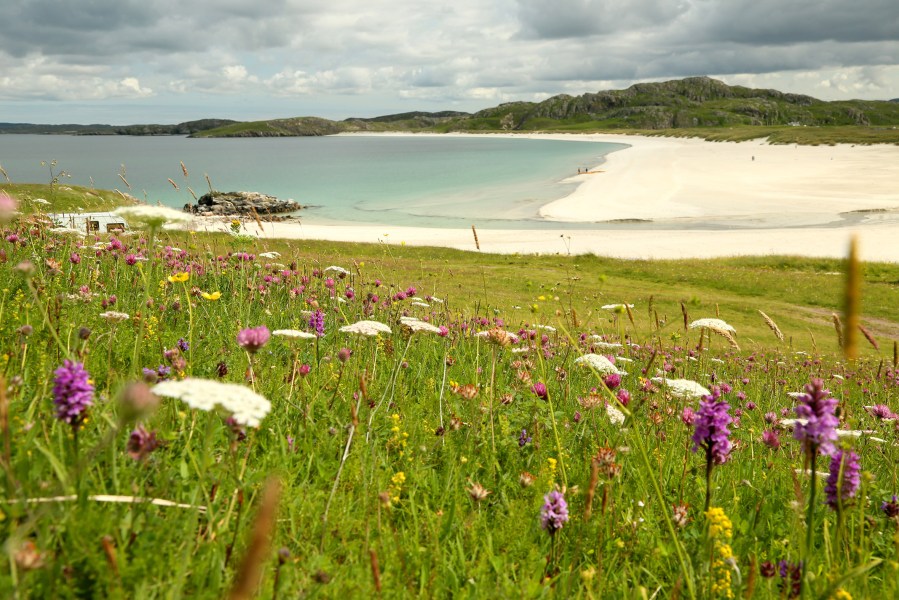Britain in bloom is a sight to behold and perhaps nowhere more so than by the coast, where unique conditions create rich ecosystems full of rare flora and fauna.
In her book
Wild Garden Weekends, Tania Pascoe offers a guide to the best places in the UK to see wild flowers. Below, she picks out her favourite places beside the sea, from orchid-covered dunes in north Wales to the surprising shingle flora of Shoreham and Dungeness and craggy cliffs covered in wild thyme on the Scottish Borders.
Scroll down to see the beautiful photo gallery.
Happy frolicking!
NEWBOROUGH WARREN, ANGLESEY, WALES
The forested warren in the Ynys Llanddwyn National Nature Reserve is one of the best coastal sand-dune systems in Britain and a haven for wildflowers from spring to autumn. Vast colonies of marsh helleborines thrive in summer when the rain filled hollows dry out, while dune pansy, early marsh, northern marsh and spotted orchids add to the beautiful display. The pretty white flowers of grass of Parnassus (Parnassia palustris) are at their peak in August. The whole reserve of dune and forest is criss-crossed by a network of paths leading down to the Menai Strait and to the island of Llanddwyn (cut off at high tide).
SHOREHAM BEACH, WEST SUSSEX, ENGLAND
This is a rare, and internationally significant habitat that is a joy to visit in summer. The vegetated shingle beach, ravaged by salty winds, is home to a diverse display of hardy, and legally protected, wild flowers. It is the only place in the UK where starry clover can be seen. Rare yellow horned poppy, white-flowering sea kale, and masses of pink and white valerian all create a colourful tapestry in the seascape.
ST CYRUS NATURE RESERVE, ABERDEENSHIRE, SCOTLAND
Stunning volcanic cliffs tower over northern Montrose Bay creating a uniquely sheltered dune grassland that is a fantastic habit for wildflowers. Vibrant displays of clustered bell flower, and northern marsh orchids are just a few of around 250 species that thrive in its mild microclimate. The reserve is rich with invertebrates – amazing diversity, considering that it's only two miles long and 500 metres wide.
PEMBROKESHIRE COASTLINE, WALES
The breathtaking coastline of Pembrokeshire is Britain’s only coastal national park and the coast path offers the best opportunity to see colourful tapestries of spring and summer wild flowers set against the sparkling backdrop of the turquoise sea. For a really wild walk head to Strumble Head, or enjoy an easy family walk from Abereiddy, stopping for a swim at Traeth Llyfn beach. Other flowers you can see on the Pembrokeshire coastline include: Coconut smelling gorse, pink sea thrift and delicate sea campion, mounds of wild thyme and stonecrop nestled in the low walls.
ST ABB’S HEAD NATURE RESERVE, BERWICKSHIRE, SCOTLAND
The dramatic cliffs and rock stacks of St Abb’s on the Berwickshire coast were created by volcanic eruptions and its craggy ledges are filled with thousands of nesting kittiwakes, guillemots and razorbills. It’s a great place for rock-pooling and wildflower walks along the grassy cliff paths. In summer the cliffs are covered in the pinky purple of sea campion, purple milk-vetch, sea thrift and wild thyme. The visitor centre can recommend trails including a perfect 2-hour loop north along the coastpath to Pettico Wick, returning south on the path along Mire Loch.
WEST PENTIRE, CORNWALL, ENGLAND
The headland of Pentire Point West is awash with incredible displays of wildflowers throughout spring and summer. Early spring starts with cowslips and pyramidal orchids, then corn marigolds and poppies appear. All thrive on the thin, acid soils of this part of the north Cornish coast, which is now managed as an IPA (Important Plant Area) for its rare arable flora. Here and behind Holywell beach you can find other beautiful plants with wonderful names, including weasel's snout, shepherd's needle and Venus's looking-glass.
ISLE OF LEWIS, OUTER HEBRIDES, SCOTLAND
Stunning machair covers the cliffs backing the sheltered, white-sand bays from Cliff beach, east to Cnip (Kneep), Bhaltos (Valtos) and on to Traigh na Beirigh (Reef Beach). Thick carpets of orchids, harebells, meadowsweet, and clover reach as far as the eye can see, enhancing awesome views of the crystal-clear turquoise seas.
MORFA HARLECH, GWYNEDD, WALES
Beneath Harlech Castle in the unique dune 'slacks' (flat ground), between views of Snowdonia and the sea, the accreting and constantly shifting dune system harbours rare sand lizards, colonies of various orchids, wild pansies and Portland spurge. Skylarks and butterflies add to the richness of the landscape, while autumn fungi, including waxcaps and puffballs, grow in the sandy hillocks. Explore with care.
Wild Garden Weekends: Explore the secret gardens, wild meadows and kitchen garden cafés of Britain by Tania Pascoe (
Wild Things Publishing, £16.99) is available from all good bookshops.





